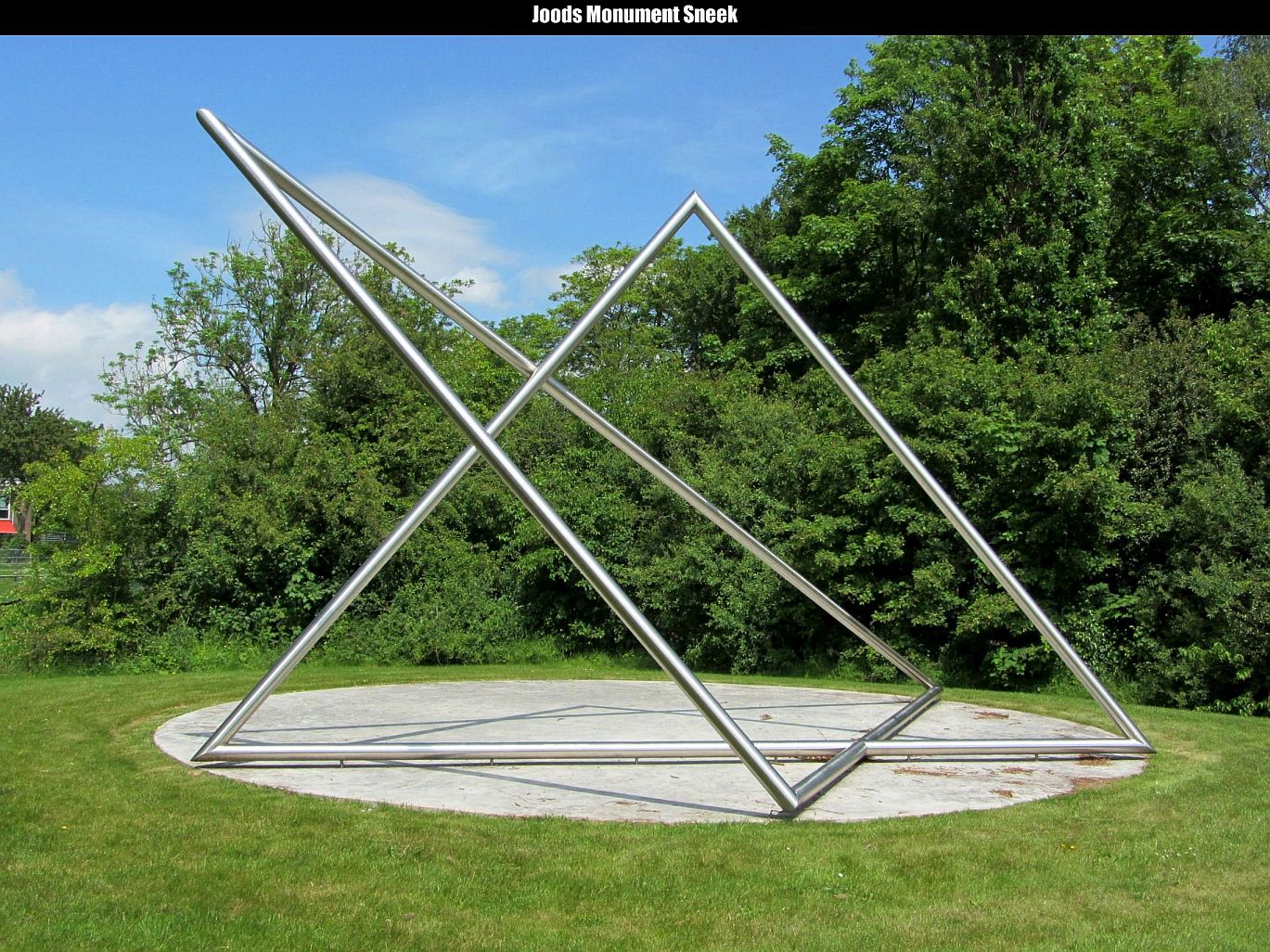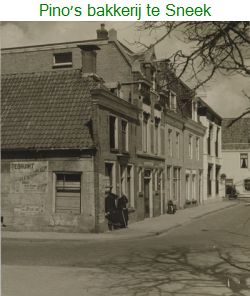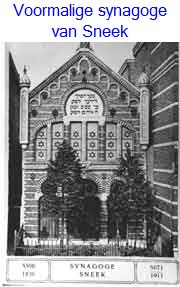The Jewish community of Sneek
Sources:
H. Beem & internet
Preface
Compared to the Jewish communities of Friesland the Jewish community of Sneek was quite young. As opposed to Leeuwarden, where already in 1670 a Jewish cemetery was established, we find an organized Jewish community in Sneek only after the French revolution. Other places, like Workum and Harlingen also had a Jewish community long before Sneek.
Not many Jews lived in Sneek. In archives from the 18th century certain Jewish names are already mentioned. The private names in these archives are not necessarily Jewish, since biblical names were also used by the gentile population. Family names however, like Cohen, Levy or Polak are a better indication, although names like Cohen or Levy were not always used as family names, but indicated that the family members were Kohanim or Levi'im.
The 18th century
The first Jew known in Sneek, Benjamin Polak, was a distiller. This profession was carried out in Friesland also by other Jews. Benjamin Polak became involved in a judicial case. He was accused of fraud, since he used vats fitted to the measure of Sneek, while the contents of the Franeker vats were larger. He won the case.
Later on more Jews moved to Sneek. But since there was no organized Jewish community, some moved to Leeuwarden.
In 1771 only one Jew was permitted to live in Sneek. He sold dyes, cotton wares and haberdashery.
Generally speaking, it was almost impossible to be granted a living permit in Sneek. He probably was allowed to live there, because he had been working in Amsterdam for fifteen years.
Most professions and functions were closed to Jews in Sneek itself and therefore they tried to sell their wares in the villages around Sneek. The Jewish Sneek community was quite poor. Many of its members lived on charity and handouts from their Jewish brethren. They also bought and sold used clothes.
In 1770 a contagious disease broke out in Eastern Europe, which broadened to the West.
The Staten Generaal issued a decree forbidding the sale of used clothing and rags in the streets and included a warning to keep a distance from "Jews carrying merchandise." Merchandise transported by ship also had to be destroyed. These decrees also applied to the Sneek community. On the other hand the Staten Generaal defended the interest of Jews trading with countries abroad. Jews and Christians were entitled to enjoy the same rights. There were also Jewish thieves and in 1769 a twelve year old boy was caught while pickpocketing.
The period of 1798 till 1813
During the 17th century Jews lived in Sneek, but never more than a few families. Towards the end of the 18th century eight Jews lived in Sneek, but in IJlst and Bolsward there lived more Jews. In 1811family names had to be adopted.
At the start of the 19th century there lived in Bolsward about 90 Jews while in Sneek remained only six Jews - one family with four children. It is difficult to understand why so few Jews lived in Sneek. Compared to other Frisian towns Sneek had no special restrictions. Possibly Jews left the town due to economic reasons.
In 1800 there were at least three Jewish families in Sneek. In 1799 there was a minyan for a circumcision ceremony, probably held in a private house. After this "summit" the Jewish population went down and in 1813 only one family was left. Afterwards their number rose quickly, but during the twenties of the 20th century their number decreased again.
The community is organized
In order to organize the Jewish communities in France, Napoleon instituted "Le Consistoire Central des Israelites de France." In 1813 Napoleon ordered the organization of the Jewish communities in the Netherlands according to the French model. In the same year the "Consistory der Circonscriptie" published a list of the synagogues, rabbis, cantors and the number of members of each community. About Sneek the following entry appears: "Number of community members unknown, estimated at 20 souls."
Prayers were held in the home of a family.
In 1814 King Willem I instituted a new organization: "Het Nederlands Israelitisch Kerkgenootschap." In this organization three types of synagogues existed: Main Synagogues, Ring Synagogues and Additional Synagogues. The synagogue of Leeuwarden was a Main Synagogue. The smaller synagogues of Friesland found it difficult to accept the authority of Leeuwarden, since it meant the loss of their independence.
The Jews of Sneek were part of the Leeuwarden Main Synagogue. Their synagogue was an Additional Synagoge.
Only from1817 were they able to hold regular services.
According to the Royal decree of 1814 all correspondence and protocols of the community had to be written in Dutch, and not in Jiddish anymore. During WWII their correspondence and protocols were lost and the history of Sneek has to be reconstructed from other sources.
In the 19th century, the cantor, who also functioned as the teacher, proposed that the Dutch language would be used in the synagogue.
The mikve was installed in 1823.
The kehilla had two parnassim. This was a difficult job, especially concerning financial matters. Each member had to pay a tax, in order to upkeep the Rabbi of their province, the cantor and to provide alms for the poor.
Regarding the church tax many problems arose, since the members were not always prepared to pay the tax, or simply were too poor to do so.
Nevertheless, in 1824 Sneek was "promoted" to a Ring Synagogue, due to the rising number of their members.
When necessary the Parnassim of Leeuwarden interfered in the affairs of their "subjects." That happened when the Jews from Sneek and their parnasim protested that the church taxes were too high. The situation changed in 1848 with the enactment of the constitution, which put an end to the interference of the state in religious matters.
The cemetery
In 1823 the community acquired a parcel of land at the Barrewier, near the Leeuwarder main road, outside the Oosterpoort, for a cemetery.
Nowadays this cemetery is situated in the center of the town. In 1890 the cemetery had to be enlarged.
As a result of a schism in the Jewish community of Sneek towards the end of the 19th century, caused by a difference of opinion regarding church taxes, a second Jewish cemetery was inaugurated, as a part of the general cemetery at the Kerkhoflaan. After some years conciliation was reached uniting the parties.
There was a burial society named Gemilus Hasodim. Both cemeteries are now maintained by the local authorities. The oldest Jewish cemetery in Friesland, situated in Workum, dates from 1664. This cemetery was added to the list of "Conserved Monuments" in 1999.
The synagogue
Due to the growth of the community the existing prayer room, which had been in use since 1819, had become too small. Since 1817 Sneek was an additional Synagogue to Leeuwarden. After seven years it became a Ring Synagogue. But the building of a real synagogue was not so simple.
The first try in 1827 was no success due to financial difficulties. In 1833 the community decided to buy a house for this purpose.
Church associations were at the time supervised by the government.
In 1834 authorization was received for the building of a "church for the
benefit of the Israelite community of Sneek, after it became obvious to His Highness, that sufficient security exists that building contractors and suppliers can be paid".
Non Jewish inhabitants of the town also donated sizable amounts.
In July 1835 the first stone was laid for the synagogue at the Wijde Burgstraat. The Jewish community obviously wanted to add splendor to this important event and therefore they requested the Mayor and aldermen of the town for permission to execute the following program:
- Twelve young ladies will strew the street from the old church to the new one with flowers. They will walk in pairs before the Books of Mozes.
- After them the Books of Mozes will follow, carried by young men.
- Afterwards these the governors of the church, the chief rabbi and a few community members will follow.
Nevertheless some problems arose. The Jewish community did not want to hold a procession and ceremonies outside the church were not allowed. The Mayor and aldermen however would be present at the inauguration which took place on the 12th of March 1836.
Other notables also attended the ceremony, including the council of the state governor of the province of Friesland, and as mentioned the Mayor and aldermen and members and officials of the court. The ceremony included choral singing and prayers, including a prayer for His Majesty the King and his family and a memorable speech by one of the church governors.
In 1880 the synagogue was rebuilt and embellished. A Moorish façade was added with decorative Hebrew inscriptions.
In the course of the 20th century the number of Jews in Sneek diminished.
In 1936 the centennial of the kehilla was modestly celebrated.
During the Second World War the synagogue was destroyed. Forty three Jews from Sneek were killed in the concentration camps. Twenty five Jews survived. In 1950 the Sneek community did not exist anymore and in 1972 Chief Rabbi Berlinger inaugurated a memorial stone.
The Torah rolls were presented to the Kfar Batya youth village in Israel. The silver artifacts from the synagogue were plundered by the Germans and were found again after the war. The remnants of the synagogue were demolished in 1949.
Societies
In Sneek, as in other Jewish communities in the Netherlands, several societies existed. Like societies for the poor, for assistance to ill members, for maintenance of the synagogue and others.
In 1929 the Lomdei Torah society was founded. There also was a Gemiloes Hassodim society, donating alms to the poor.
The Alliance Israelite Universelle and the Dutch Zionist Organization maintained branch offices in Sneek. The Hesed We'emet society assisted the dying and took care of the burials. There was a ladies' society which cared for the parochet and the Torah mantles in the synagogue.
Livelihood
The Jews of Sneek were mostly traders and some of them were butchers. There was street trade and there were some peddlers. There was much poverty. Collections were held for the poor, to which non-Jewish inhabitants also contributed. In 1835 there was a doctor and more community members started studies. In 1855 one member passed the exam for civil servants in the Eastern- Indies, today's Indonesia. At the time this was something special and it was reported in the Israelitische Weekblad and in the Sneeker Courant.
Schooling
In 1854 the Jewish community wanted to open a school for 25 pupils. Since the Jewish community was unable to finance this undertaking, they approached the Provinciale Staaten of Friesland, requesting a subsidy, to be paid by the Sneek municipality. The city council rejected the request, and the project had to wait till 1873.
About 1900 the community had a teacher, who also functioned as a cantor and shouchet. The school had five classes and one teacher. The children studied there till their 11th year.
The Jews of Sneek and surroundings
|
Year |
Population |
|
1809 |
13 |
|
1840 |
144 |
|
1869 |
127 |
|
1899 |
132 |
|
1930 |
49 |
As mentioned above, 43 Jews from Sneek were murdered during the Second World War.
Extracted from sources:Yael Benlev-de Jong
Translated from Dutch:Mechel Jamenfeld
Editing:Ben Noach
Final editing:Hanneke Noach
[an error occurred while processing this directive]
[an error occurred while processing this directive]

Monument

